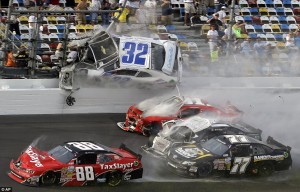Sporting Event Injuries: What to Do When You Get Hurt Watching the Game
 It starts off with excitement and anticipation as you make your way to the big game, but there are worse things that can happen there than your favorite team losing.
It starts off with excitement and anticipation as you make your way to the big game, but there are worse things that can happen there than your favorite team losing.
Sports events injuries don’t just happen on the field of play, as Manhattan personal injury and accident lawyer injuryclaimnyclaw.com will confirm, as people can and do get hurt in a variety of ways while watching the game.
Who’s fault is it?
Anything can happen. A puck hits you on the head or maybe you slip and fall while grabbing a hot dog, the question is, whose fault is it that you have been injured
The important phrase to bear in mind is assumed risk. What this means in basic terms is that when you attend a sporting event as a spectator, you do so on the understanding that a flying object like a ball or a puck might enter the seating area, so it is your responsibility to takes steps to avoid them when that happens.
You will often find a clear definition of your assumed responsibilities printed on the back of your ticket, in the form of a carefully worded statement warning the ticketholder of the potential risks they should accept when entering the stadium.
Where things get more complicated is if you sustain an injury that is not inherently associated with the nature of the game.
Examples of potential negligence
If parts of the stadium are in a poor state of repair and a crumbling or worn walkway causes you to suffer a fall, that is an example where it may be possible to prove that the stadium owner was negligent and could be found guilty of not properly maintaining the grounds.
Another example which perhaps might surprise you, concerns a patron getting intoxicated.
If a patron is served alcohol where it is clear that they are already intoxicated and should be refused a drink, the bar or restaurant concession could potentially be liable for over-serving intoxicated patrons, if they subsequently get injured as a result of being drunk and injuring themselves in some way, like falling.
Hazardous conditions
Your main focus of attention when attending a sporting event is to enjoy the spectacle of the game and the company of fellow fans.
It always makes sense however, to take a look around at your immediate surroundings and see if your spot any potential hazards, which could cause an accident. If you notice that protective netting is loose or unsafe for example, or you notice that handrails are not secured properly, always notify an attendant of your concerns.
Spotting potential hazards and making someone aware of them will definitely help if you are subsequently injured through an incident that you cannot expect to be covered by assumed risk.
Getting struck by a baseball or some loose debris during a NASCAR rally is something that you might expect could happen when you attend, but there are a variety of different injuries that you could suffer, where someone other than you should take the responsibility.
Michelle Lawson has had various jobs working in safety and risk management roles most of her working life. She likes to share her thoughts online and writes for a wide variety of blogs on safety topics.
Yes, racing casues the worst injury in sports. That's the reason I don't lke to watch racing games, but I love cricket always.
cricket is also not with zero death rate because hard ball damages a lot.